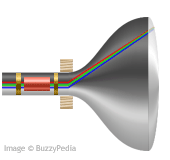Whenever images are involved, moving or not, we encounter the term
resolution. Everybody knows that higher resolutions are better than lower resolutions. But that's as far as most people's knowledge goes. Sometimes a resolution is given in
Megapixels as with digital cameras, sometimes with a few numbers like
1024x768, and other times as a term like
1080i. But they all refer to the same thing: the number of dots or
"pixels" that make up the image on a photo or a screen.

Not so very long ago, all TVs were just boxes with a big electron tube in them. An electron beam simply swept across a chemically treated glass surface (your TV screen) and wherever the beam hit the screen, that's where the screen would be lit up. The number of lines had to be the same for every TV, as well as the time it took for the beam to scan from left to right over the screen since it was the signal broadcasted by TV-stations that indirectly controlled the beam. So the "resolution" was the same for every TV, which meant that resolution for a DVD player was a moot point. Now fast-forward a few years.
HDTV (or "High Definition TV") is introduced. The big difference from the old TV format is that this is a
digital format. Instead of broadcasting an "analog" signal that controlled the beam on your TV, "digital" information is sent. Basically, this is the same as simply sending a file to your receiver box and playing it. However, in this case, the file is played instantly (and not stored) as it's being received. The data is being
streamed.
As with all digital video formats, the digital data holds information for each single point (or
pixel) on your screen. It also holds the data for audio. And it can be compressed too. No longer does the TV signal indirectly control the electron beam in your TV. Instead, you receive data and it's up to your TV or receiver box to do with it as it pleases.
HDTV comes in several flavors. They are called
1080i,
1080p,
720i and
720p. The number is shorthand for the actual resolution of the image. 1080 stands for 1920x1080 (1920 pixels horizontally by 1080 pixels vertically), while 720 stands for 1280x720. Both resolutions are much higher than the resolution of an ordinary TV. The "i" and the "p" stand for "
interlaced" and "
progressive scan" respectively (more on that later).
As of yet, all DVD movies are tailored for ordinary TVís, which means they carry the same resolution as these TVs. But now that High Definition TVs are becoming more common, an upgrade to the DVD standard is necessary as well to get the most out of these TVs. The higher resolutions require a new DVD disk standard because current DVD disks are already up to maximum capacity and donít have the space to store the larger data files which are inherent to these higher resolutions.
Copyright © 2006 - BuzzyPedia.com

